- RNG Mechanics
- Home
- RNG Mechanics
- Battling
- Guides
- Battle Challenges
|
Egg RNG in Generation 7: Guide (macOS users)
- Introduction
- Egg RNG (Windows users)
- Egg RNG (macOS users)
- Finding your Egg seed
- Using .com's Egg RNG Tool
- Finding and obtaining the Egg you want
- Step-by-step example
- Additional resources
3.1. Finding your Egg seed
The biggest hurdle to navigating your Egg chain is knowing where you're starting from (what your current Egg seed is). Finding this out is the first and by far the longest step in the process. Follow these steps with precision:
- Catch a male and a female Magikarp with different natures, and take note of which nature belongs to which gender. Attach an Everstone to both of them. Everstones can be obtained from wild Roggenrola at Ten Carat Hill (they have a 50% chance of holding them).
- Deposit both Magikarp at the nursery.
- Run until the nursery lady is holding an Egg. Do not talk to her yet.
- Save the game, and then accept the Egg and hatch it.
- Check the nature of the hatchling. If it has the male's nature, note down a 0 in a blank Notes document or similar; if it has the female's nature, note down a 1.
- Soft-reset the game (L+R+Start).
- You should be next to the nursery lady holding the Egg; talk to her and refuse it.
- Repeat steps 3-7 126 times (!), writing down a new number next to the previous one every time. You will end up with a string of 127 0s and 1s. At this point, your in-game character should be standing next to the nursery lady, having just refused the 127th Egg.
- Go to this website. In the first field (under "連続127個の最下位bit列を01で入力してください。"), paste the string of 127 0s and 1s you wrote down and click the button underneath. The website will return a seed comprised of four parts, ordered as 3, 2, 1, and 0. Note down this seed, since it will be needed find your current Egg seed.

- Go inside the nursery and take both Magikarp out, remove the Everstones, and deposit them again.
- Open .com's Gen 7 Egg RNG Tool and input all four parts of the seed the website gave you on the right, under "Seed". Be careful, as the website's seed parts are listed in the order of 3, 2, 1, and 0, which will require you to start inputting the seed from the bottom! Once that's done, click the "Search" button. The application will display a list of Eggs under "Results", numbered by the "Frame" listed on the left. Scroll down to frame 124, and take note of the nature and gender of that Egg.
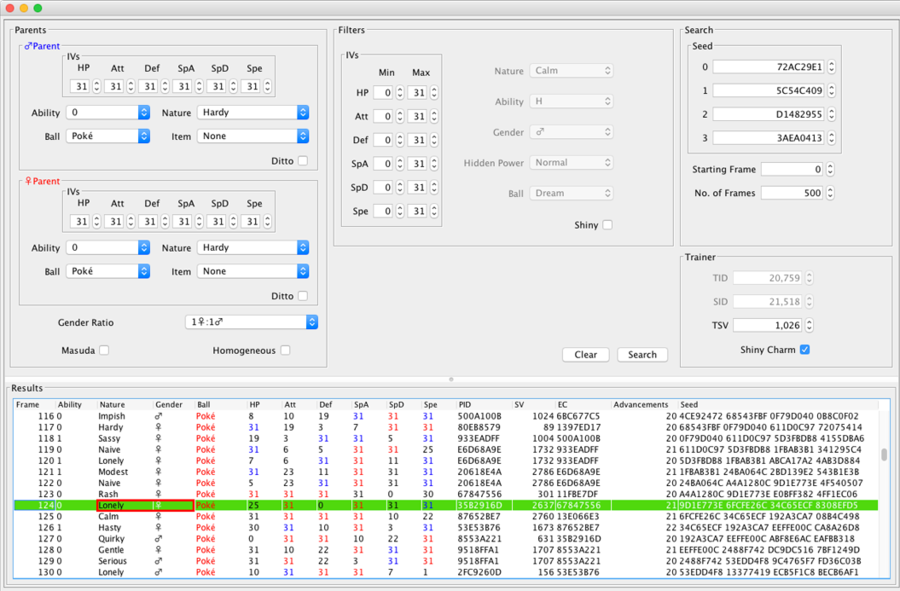
- Step outside the nursery and run until the nursery lady holds a new Egg. Save the game, and then accept the Egg.
- This is it; this is where we find out whether everything was done correctly... now is the time to break a sweat. If all is good, you will have your seed and be able to use Egg RNG indefinitely. Take a deep breath and hatch the Egg. Curl up your toes as you watch yet another Magikarp break free. Check the nature and gender of your new Magikarp; if they correspond to those noted on step 12, congratulations, you're almost done and may now proceed proceed to step 14! If not, you most likely made a small mistake somewhere along the string of 0s and 1s, and you will probably never know where; you unfortunately need to start again.
- Soft-reset and refuse the Egg the nursery lady is holding. Take back both Magikarp and feel free to release them to join their 127 new offspring in the wild. Or maybe you want to thank them for all their help with a couple of delicious beans in Pokémon Refresh? This is up to you, really!
- In .com's Gen 7 Egg RNG Tool, scroll down to frame 125 (just under the one you used as a test; since you just refused that Egg, you advanced in the chain by one frame). Take a look at the seed in the right column of the results: this is your current Egg seed! Note it down (you don't want to lose what you worked so hard to obtain!) and replace the seed under "Search" with this one (this time, it's already in the correct 0, 1, 2, and 3 order).
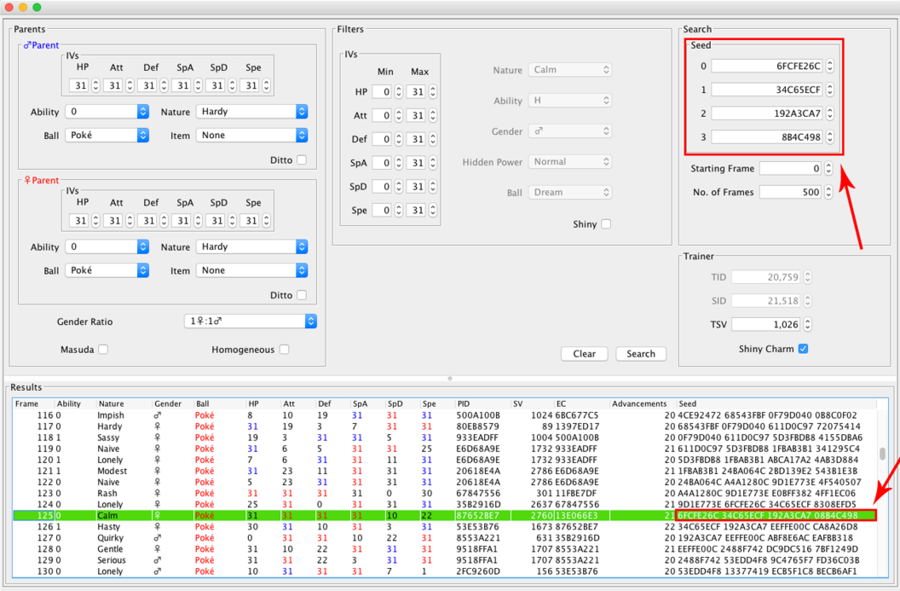
That's it, you are now ready to search for upcoming Eggs!
Tips and tricks
- Magikarp are used because they hatch the fastest; this method could be used with different Pokémon as well.
- Having a Pokémon with the ability Flame Body or Magma Armor (such as Magby, Magcargo, or Volcarona) in your party will make Eggs hatch twice as fast.
- Route 6 down from the nursery is a long straight line, making it ideal to run along with Tauros and hatch Eggs without turning often. Hatching one Magikarp will only require you to go back and forth twice through the Route (with Flame Body/Magma Armor in your party).
- Those using the 127 Magikarp method may want to plan the time they do it in advance. It requires about 3 to 4 hours of concentration while doing a repetitive task and making sure not a single error is made. Be careful of multitasking (such as watching videos at the same time) because taking your attention away will eventually make you doubt the order of your actions and could ruin your chain. Listening to music is probably a less dangerous way to make the process less boring!
3.2. Using .com's Egg RNG Tool
To proceed and find the Eggs you want using .com's Gen 7 Egg RNG Tool, you will need to input all necessary information on the parents you deposit and know how to filter your search. While most of the settings are pretty straightforward, first-timers should take a moment to look at what every part does:
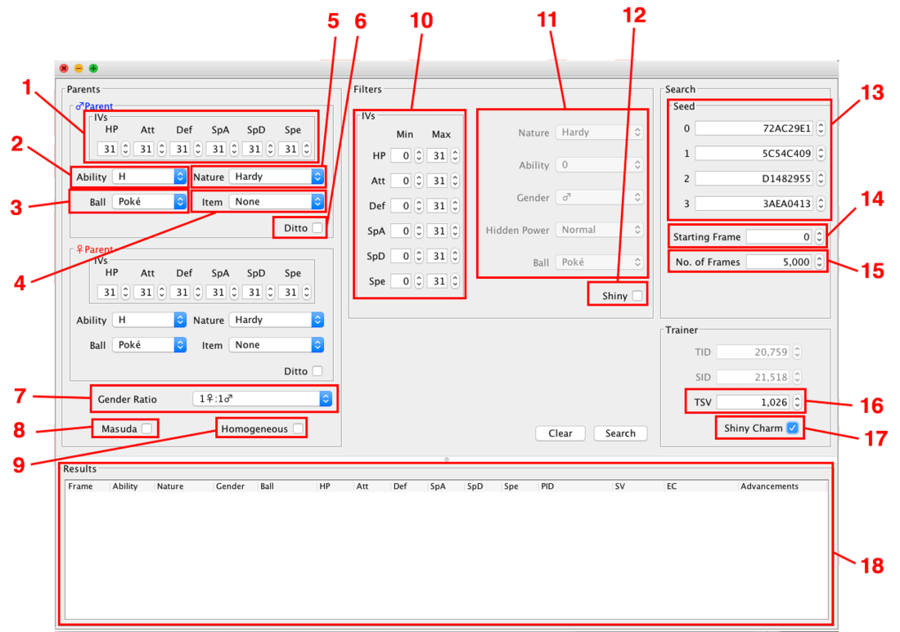
- Enter the male parent's IVs here. If some are unknown, you can substitute them with a "1"; whenever that IV is passed from the parent, it will also show as a "1" in the Egg listing, and shouldn't interfere with your filters. The ones you will definitely want to enter are the 31s, 30s, and 0s.
- Pick the ability of each parent, with "H" representing the hidden ability. If the Pokémon only has one regular ability, picking 1 or 2 makes no difference. Otherwise, the first ability listed in common resources corresponds to slot 1, and the second corresponds to slot 2; for example, Clefairy's slot 1 ability is Cute Charm, and its slot 2 ability is Magic Guard.
- Enter the type of Poké Ball the parent was caught in. This is important if you are trying to pass down a specific type of Ball to the offspring, as it will enable you to predict which type of Ball each Egg will be in.
- Pick the item this parent is holding (you will usually want one of them to hold an Everstone to pass down the nature, and the other a Destiny Knot to pass down 5 IVs from the parents).
- Pick the parent's nature. If that Pokémon alone is holding an Everstone, that nature will be passed down to the offspring, but if both are holding Everstones, the application will be able to predict which nature each hatchling will have.
- Check this box if you are using a Ditto instead of this gender's parent. In the case of a genderless Pokémon, Ditto will always be the female.
- Pick the Pokémon's gender ratio. This is important in predicting whether you will hatch a male or female.
- Check this box if you are using the Masuda Method, which means one of your parents is marked as coming from a foreign region in-game. This is important, even if you aren't trying to hatch a shiny Pokémon. Breeding with foreign Pokémon will yield slightly different results, so it needs to be checked whenever you are using parents from two different regions.
- Check this box if you are breeding with two parents of the same species. For example, check it if you are breeding a male and female Mareep together, but don't check it if you are breeding a Mareep with an Ampharos.
- Enter the IV range of the Pokémon you want to find. If none of your parents have the right IVs, you shouldn't set your standards too high; try to obtain just a few perfect IVs. Afterward, use that new Pokémon as a parent to find even more perfect IVs, and eventually all of them. If you are fortunate enough to have a Ditto with flawless IVs, you can probably afford to set your standards pretty high and set the exact IVs you are looking for here. If you are looking for some specific Hidden Power types, section 4.3 of this guide lists a few common IV spreads you may want to enter here.
- These are various attributes you may be looking for in your hatchling. To activate one of the filters, click its name. Only pick the ones that are important to you, as every additional filter will make it harder to find what you want! Before choosing the Ball, you may also want to check section 4.2 of this guide if you are unfamiliar with the breeding mechanics for Balls.
- Check this box if you are looking for a shiny Pokémon. When searching for a shiny, most of your results will probably be very far into the chain (hundreds or thousands of frames away). To avoid having to go too far for one, don't set many other filters (flawless shinies are rare!). Do not use this checkbox if you don't know or haven't entered your TSV in 16. To use this feature, you also need to have received the Shiny Charm (17) or be using the Masuda Method (8).
- This is your current seed. It will need to be updated every time you finish a project. Make sure to always note it down before you exit the program, as it may get reset every time it gets restarted!
- This is the frame from which your search will be started. It should usually be 0.
- This is the number of frames you want the application to search through. If you only want to see a list of what's coming, 500 is reasonable. If you want to conduct a search using filters, you may want to broaden the search with a high number of frames. When searching for specific IVs, abilities, or Balls using good parents, 1000 is usually plenty. However, if you are looking for shinies, a greater number is recommended, at least 50000. Feel free to explore and experiment with the range, but be careful of using a number greater than 500000, as it may cause the application to crash if your computer has trouble handling a heavier load.
- If you know your TSV, enter it here (see section 1.2 of this guide of you don't know what TSV means).
- Check this box if you have obtained the Shiny Charm in-game.
- Results of your search will be shown here when you click the "Search" button.
3.3. Finding and obtaining the Egg you want
With the interface of .com's Gen 7 Egg RNG Tool all figured out, you are now ready to search for a specific Egg and obtain it! Here is the procedure:
- Pick both parents you will be using to breed and enter all their information by filling in fields 1-9 in .com's Gen 7 Egg RNG Tool.
- Enter the features of the Pokémon you wish to hatch in fields 10-12. Make sure to be realistic; if you set your standards too high, you may struggle to find results!
- Leave the Starting Frame (14) as 0, and set the number of frames (15) to an appropriate number for what you are trying to obtain (see the description of field 15 for examples). The default number is 5000, which can be left untouched if you're unsure.
- Click "Search", and take a look at the results. If there are too many, you can either be more strict with the filters or reduce the number of frames. If there are too few results or none, either be less strict with the filters until you breed better parents or increase the frame range. Once you've found an Egg you'd like to obtain, note down its frame number.

- Disable all filters, reset the IV ranges, and set the number of frames to something that will ensure you will still be able to scroll down to your desired Egg's frame. This can simply be the frame number + 1. For example, if I am aiming for frame 173, I will write 174. Hit "Search" again.
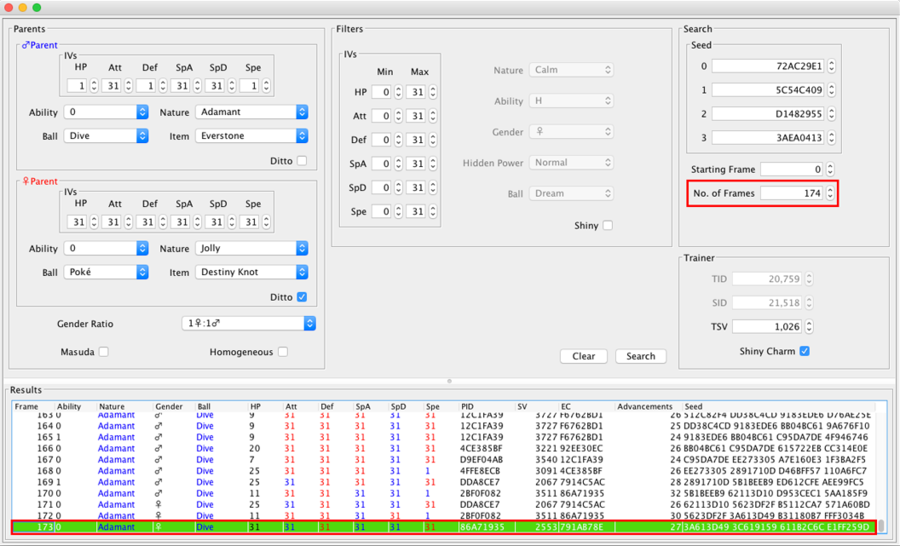
- Find out how many Eggs you will need to accept and refuse in order to reach the frame you set as your goal. This step requires you to have read and understood section 1.1 of this guide. Notice the "Advancements" column in the results: this is the number of frames you will advance by when you accept the Egg tied to each frame. For example, in the case below, accepting the Egg of frame 0 will advance my frames by 21.
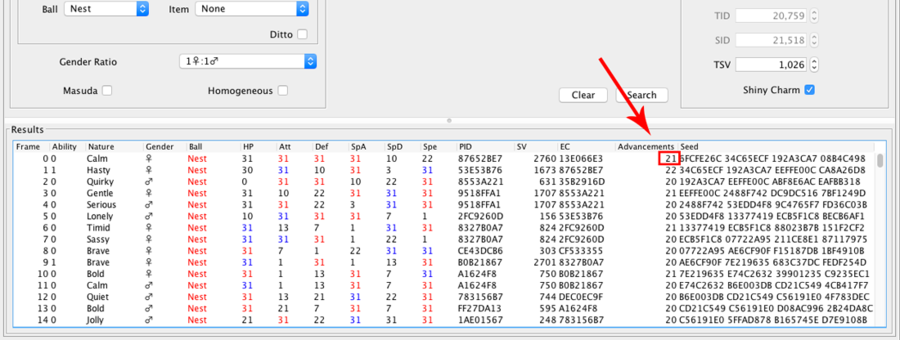
This means accepting it will send me down the Egg chain directly to frame 21 (0+21). However, when you refuse the Egg of a frame, you will always skip to the next one, meaning if I refuse my very first Egg, I will have moved to frame 1 (0+1). Thus, accepting and refusing Eggs will carve your path to getting the precise one you wish for. The easiest way to go at it is to continuously accept Eggs and keep track of your advancements until accepting the next Egg would bring you past the one you want. At that point, you can start refusing Eggs until you reach your desired frame.
For example, if I want the Egg of frame 63 and am starting from 0, I will start by accepting the first one, bringing me to frame 21. I will then accept a second Egg, and since 21's advancements number is 20, I will now be at frame 41 (21+20).
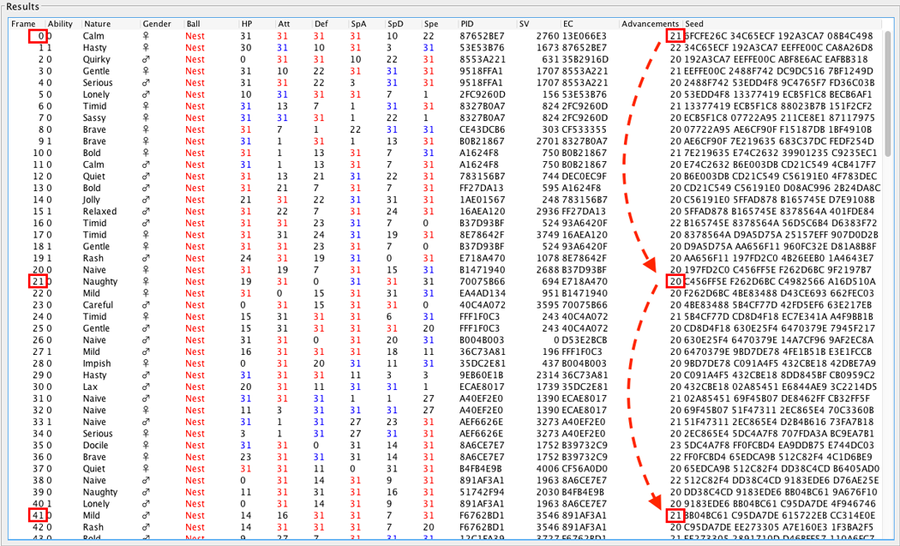
The advancements number here is 21, so accepting a third Egg will bring me to frame 62 (41+21), just one short of 63. Accepting a fourth Egg would bring me past 63, so instead, I will refuse an Egg and advance to 63. All in all, getting to frame 63 will have required accepting 3 Eggs and refusing 1, in that order.
- Deposit both parents in the nursery and run around the nursery lady. Accept and refuse Eggs in the order that was settled on at the end of step 6. Saving before starting this process may be a good idea in case you make a mistake. Once you are done, run until the nursery lady is holding another Egg; that Egg will be the one you were aiming for. Accept it and immediately take the parents back from the nursery so that no further Eggs are generated.
- Hatch the final Egg and make sure it corresponds precisely to the one you wanted. If it does, congratulations, the operation was a success! If it doesn't, there was an error somewhere, and you may want to soft-reset to an earlier state where you knew your current seed and frame. If you don't know where you are in the chain anymore (i.e. nothing you breed corresponds to the expected results), do not panic and do refer to section 4.1 of this guide.
- Have a look at the advancements column of the final Egg you accepted, and use it to determine which frame you are currently at (final frame + advancements). In our example where the Egg of frame 63 was set as the goal, the advancements of frame 63 is 20, and 63 + 20 = 83, meaning 83 is our current frame.
- With all filters still disabled, make sure the number of frames is set higher than your current frame (84 or more in our example) and search again. Go to you current frame and take a look at the "Seed" column on the right. This is your current seed; make sure to write it down for next time (the application may reset it when you reopen it, so always keep your current seed safe somewhere).
Tips and tricks
- In the search results, IVs inherited from the male parent appear in blue, while those inherited from the female parent are red. This can be very helpful when finding shiny frames, since switching out the parents will still give you the exact same frame. For example, if you find a shiny frame with 31/31/1/1/31/31 IVs where both 1s are being passed down by the male, you can switch the male parent with one that has 31 in both Defense and Special Attack in order to have a flawless shiny!
- Forgot to take back the parents before hatching the Egg you wanted, and now the nursery lady is holding a new Egg for you? No cause for concern! Simply find the frame you ended at after doing the advancement from your final Egg as you usually would, then take a look at the very next frame: since you are refusing an Egg, you will advance by one frame, so this will be your current frame! Note that you may need to disable the filters and increase the number of frames in order to have the next frame displayed.
- Are you a math wizard? Then you're in for some fun! While accepting Eggs until the next one would make you skip over your target is the easiest way to navigate the advancements, refusing various Eggs in the middle of the process could significantly alter the path you take to the final frame. Remember that every time you refuse an Egg, your advancement is 1. Those with enough skill and time will surely be able to find paths that require accepting and/or refusing less Eggs overall, making the process a little quicker.
3.4. Step-by-step example
Phew, that was a lot of information to absorb! Let's apply the process of Egg RNG step by step to a specific breeding project as an example. In this case, we will attempt to get a shiny Chinchou in a Dream Ball with its hidden ability Water Absorb, a Calm nature, and the best possible IVs (ideally 31/0/31/30/31/31, which grants it Hidden Power Grass). We have the following parents to begin with:
- A female Quick Ball Chinchou with Water Absorb and a Jolly nature, which we caught using S.O.S. battles. According to the IV Judge, its IVs are Best/Pretty Good/Very Good/Decent/Best/Best, which we will mark as 31/1/1/1/31/31 (anything that isn't 31, 30, or 0 is irrelevant).
- A male Dream Ball Chinchou with Volt Absorb and a Calm nature, which we received in a trade. Its IVs are 31/x/31/31/31/31.
- We're also fortunate enough to have a German Ditto (a region foreign to ours) with the IVs 31/0/31/31/31/31, which we received from a giveaway on Smogon's Forums.
First, we will breed the two Chinchou together to get the Ball, nature, and ability we want in a single Chinchou; this will allow us to continue the process using the Ditto instead. Let's enter the parents' information in .com's Gen 7 Egg RNG Tool, check "Homogeneous" because these are two Chinchou, and see if we can get a decent parent to get going. In the filters, we'll lock in the Ball as Dream, the ability as "H" so it has Water Absorb, and the nature as Calm. As for the IVs, we'll enter all the 31s we want in the final Chinchou, but since we have no parent with 0 in Attack or 30 in Special Attack, we can leave these blank; aiming for only flawless IVs would be a stretch right now. Setting the number of frames to 500 seems reasonable; any more than that would take a long time to get, and we should be able to find what we want in that range. Let's see what results this yields!
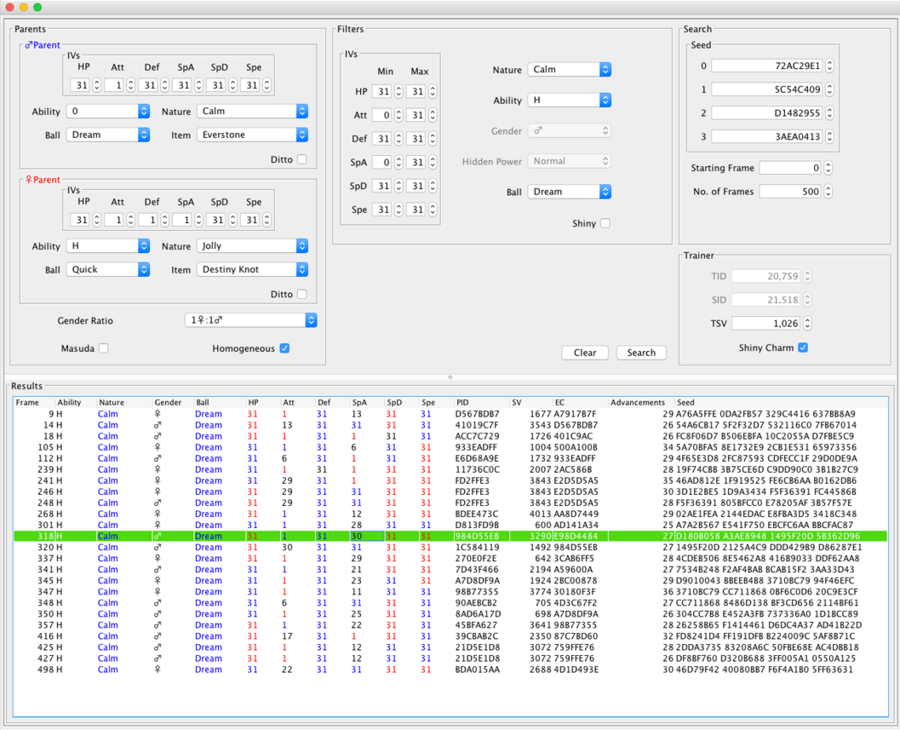
Looks like this is our lucky day! The one at frame 318 has everything we want, plus the 30 we needed in Special Attack! It will take us longer to obtain than the first few results, but since we had no parent to pass down the 30 stat, this seems well worth the effort! Let's calculate how we can get to frame 318. First, we shall disable all filters and set the number of frames to 319 to see a full list of frames leading up to 318.
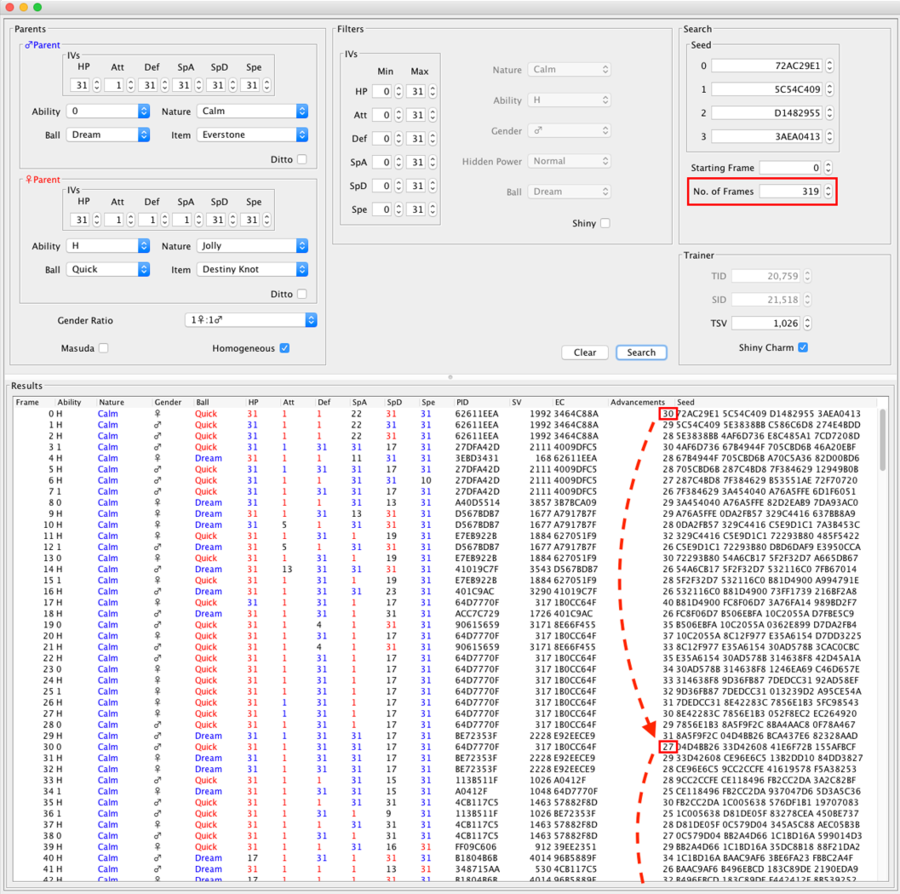
Time to start calculating and see how many Eggs we'll need to accept and refuse to get to 318! The starting frame's advancements number is 30, so accepting 1 Egg will bring us there. Frame 30 has 27 advancements, which will lead us to frame 57 (2 Eggs accepted now). This one has 27 advancements again, bringing us to frame 84 (3 Eggs accepted).
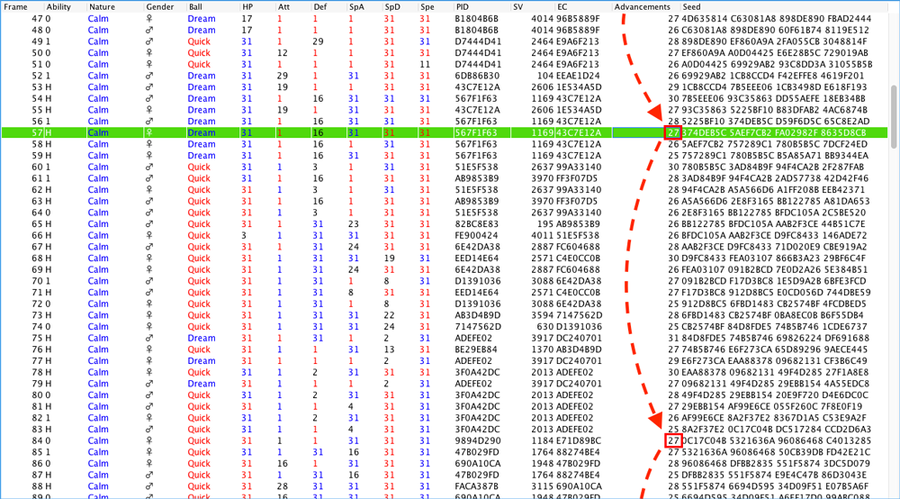
By now, you probably get the gist of it, but we'll cover the entire operation this once since 318 isn't so far. With another 27 advancements, we will be at frame 111 (4 Eggs), which in turn has 30 advancements, bringing us to 141 (5 Eggs). This one has 30 advancements again, so we head to frame 171 (6 Eggs), which advances us by 27 to frame 198 (7 Eggs). Here we have 31 advancements, so frame 229 is next (8 Eggs). After the 25 advancements from frame 229, we reach frame 254 (9 Eggs), and then 283 (10 Eggs) with 29 more advancements. Finally, after the 33 advancements of frame 283, we get to frame 316 (11 Eggs), which is only two away from our goal. This mean we will then need to refuse 2 Eggs to reach 318.
We now have our plan: accept the first 11 Eggs, then refuse 2, and by accepting the next one, we should get our 31/x/31/30/31/31 Calm Chinchou in a Dream Ball with the hidden ability! Let's do just that, and after accepting the final Egg from frame 318, we will make sure to immediately remove the parents from the nursery. Accepting the Egg from frame 318 made us advance by 27 frames to frame 345, so we should now change the no. of frames to 346 and have a look at the seed matching frame 345. This seed is the new seed we will be starting our next project from, so we shall write it in the "Seed" field at the top and note it down elsewhere to keep it safe. Losing track of your seed can be costly, so always make sure to keep it safe!
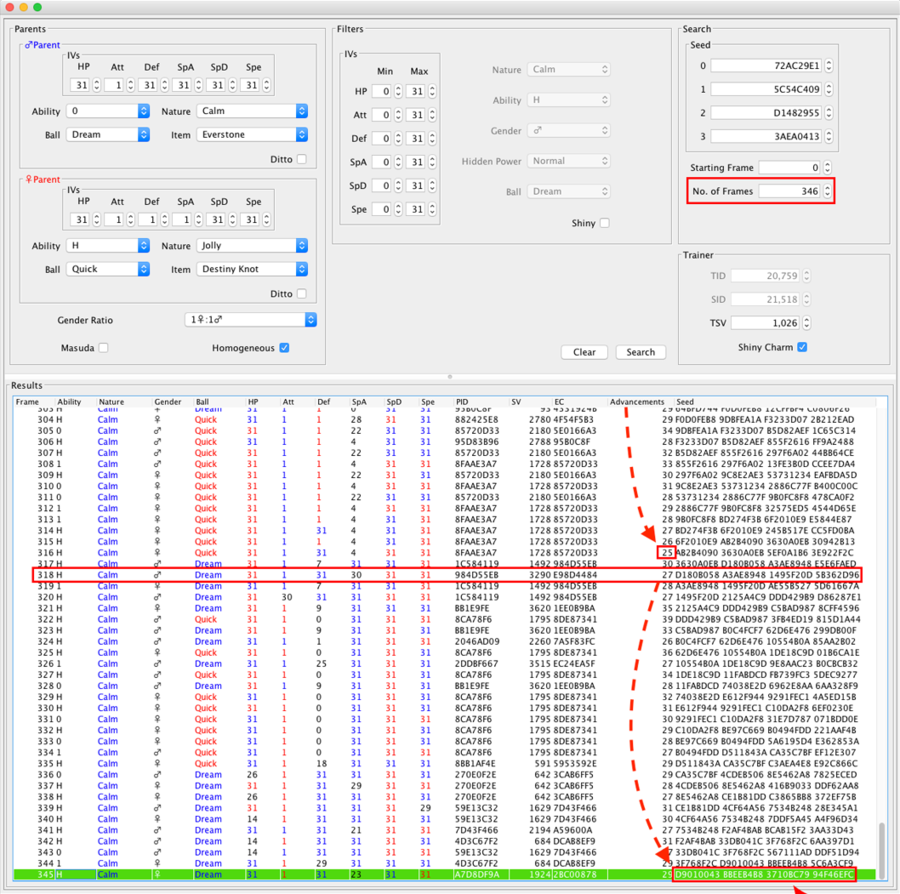
Next, we will breed the Chinchou we just hatched with the German Ditto to try obtaining the shiny Chinchou we wanted. Let's update the parents' information, making sure to check the "Ditto" box this time as well as the "Masuda" box since the Ditto is foreign. Finding a shiny with Hidden Power Grass and flawless IVs is a very long shot, so we'll leave the Attack range at 0-31 and see what our options are. 50000 is a reasonable number of frames when searching for a shiny; any more than that would require going through an insane number of Eggs. Here we go, fingers crossed!
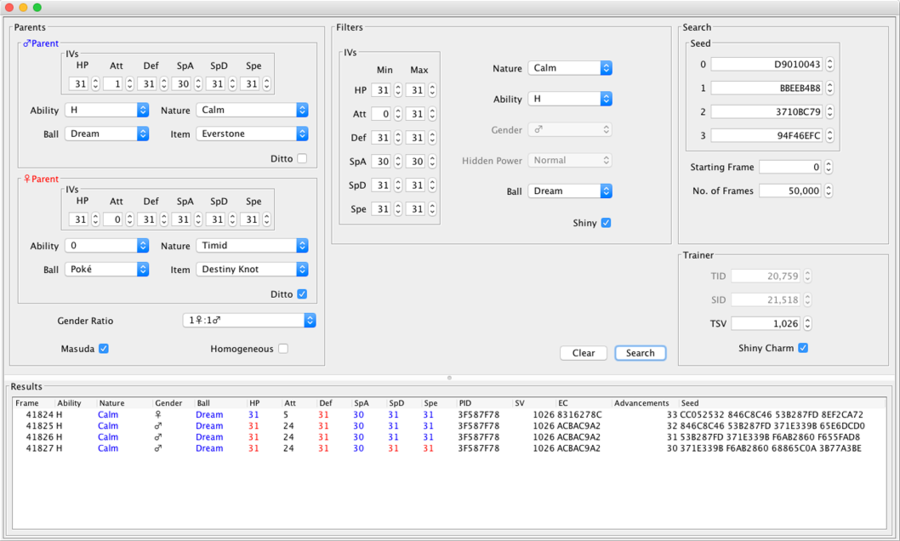
Ouch, not our lucky day after all! The closest ones are more than 40000 frames away. Three of them do have Hidden Power Grass, at least, though their Attack stats are a bit high.
With an average of 3 Eggs accepted per 100 frames, we would have to hatch around 1250 Eggs to get there! The exact number isn't worth calculating until we know we're going to do it, and we don't exactly have the time to hatch 1250 Eggs right now! Maybe we were a bit greedy trying to get Hidden Power Grass along with 5 perfect IVs. Let's run a new search in the 0-50000 frame range, but this time allowing Eggs that have 31 in Special Attack as well.
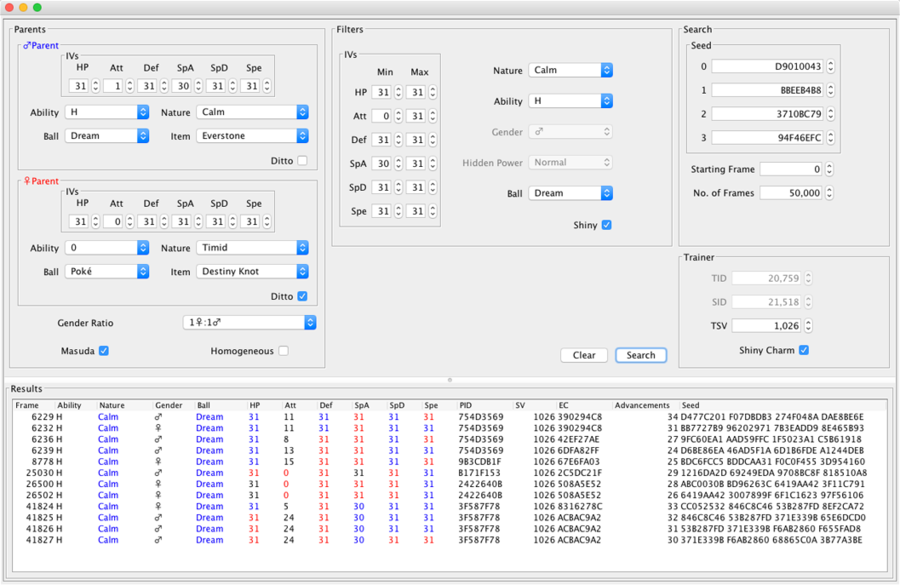
Well, those are some interesting options. We could actually get a 31/0/31/31/31/31 Chinchou by setting our target frame to 25030; this would be a pretty amazing shiny! But then again, we would probably still have to accept 700+ Eggs. Since we would like to be done with this project quicker, these shiny Eggs between frames 6229 and 6239 are looking pretty appealing. The one with 8 in Attack at 6236 would be reasonably good, so let's start calculating to see how many Eggs we need to accept and refuse. At this point, we will remove all filters, set the number of frames to 6237, and hit "Search" again.
From there, the process is exactly the same as we've done above, just a lot longer. We'll keep adding advancements and jumping frames until the next advancement would make us skip over the target. In our case (I will spare you the calculations), accepting 185 Eggs in a row will take us to frame 6218, after which we will need to refuse 18 Eggs to reach 6236 (6236 - 6218).
Accepting 185 Eggs and refusing 18 for a such a good shiny Pokémon is more than reasonable, so we should probably settle for this! Keep in mind that the other shiny frames we found much further down the Egg chain will still be shiny if we use other parents; some of them might even still be shiny without using the Masuda Method. It could be worth checking by running a search and tweaking the inputs. In any case, not using them now will allow us to save them for a later project. As long as we don't go past the points they were at in the chain, those shiny frames will be waiting for us at those points.
Now, let's go through the process of accepting 185 Eggs and refusing 18. As we accept and hatch Eggs, we need to regularly check our hatchlings and make sure they correspond to the predicted ones, and save our game when we know all is going according to plan, just in case a mistake happens in the future. Once again, after accepting a 186th and final Egg, we have to make sure to remove the parents from the nursery to prevent any further Egg from being generated. We can then change the number of frames to 6264 (since accepting the one from 6236 advanced us by 27 frames to 6263), hit "Search" again, and replace the current seed with the one from frame 6263 for our next project.
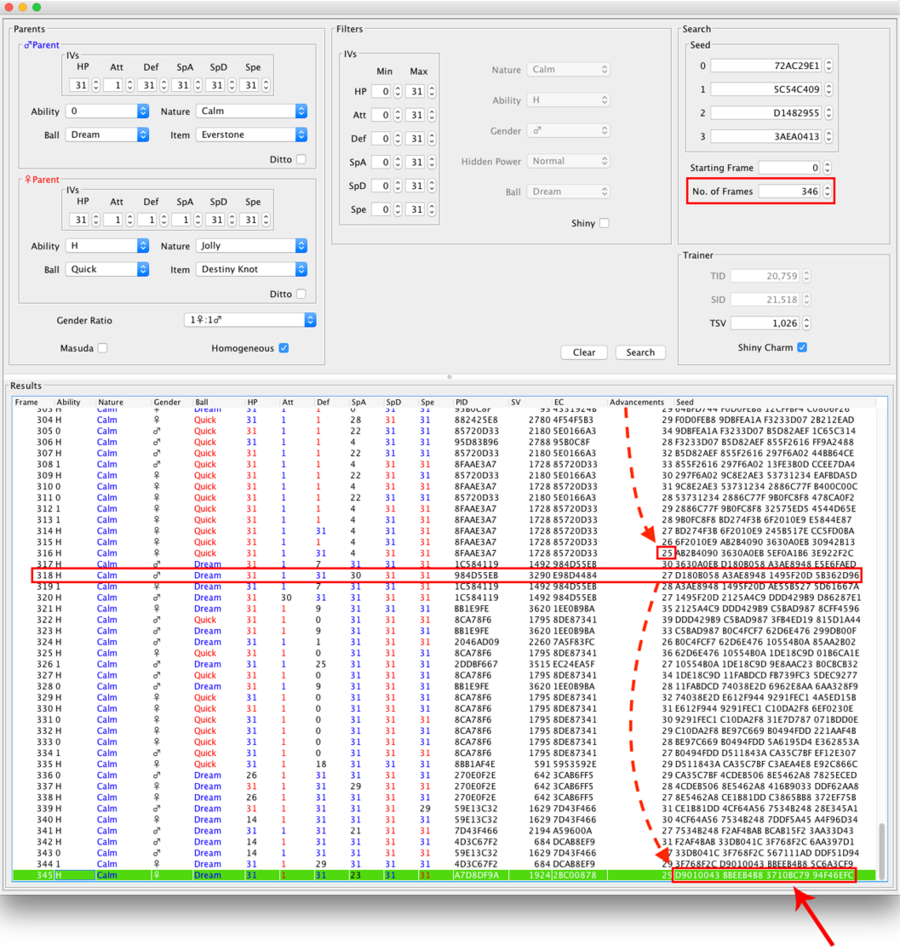
Time to hatch the final Egg; let's go to Brooklet Hill to hatch it, since it would be a nice place to have as the hatching location in the shiny Chinchou's summary!
Yay!
You should now be all set to do Egg RNG on your own for years to come; happy breeding!
|

















